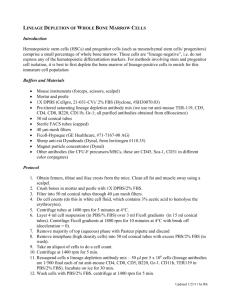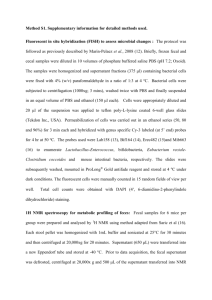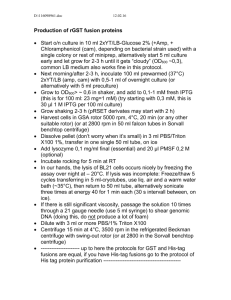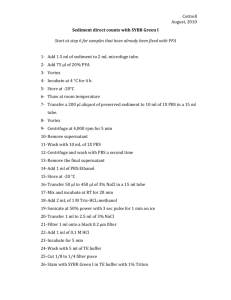Supplemental Materials & Methods Triglyceride quantification For
advertisement
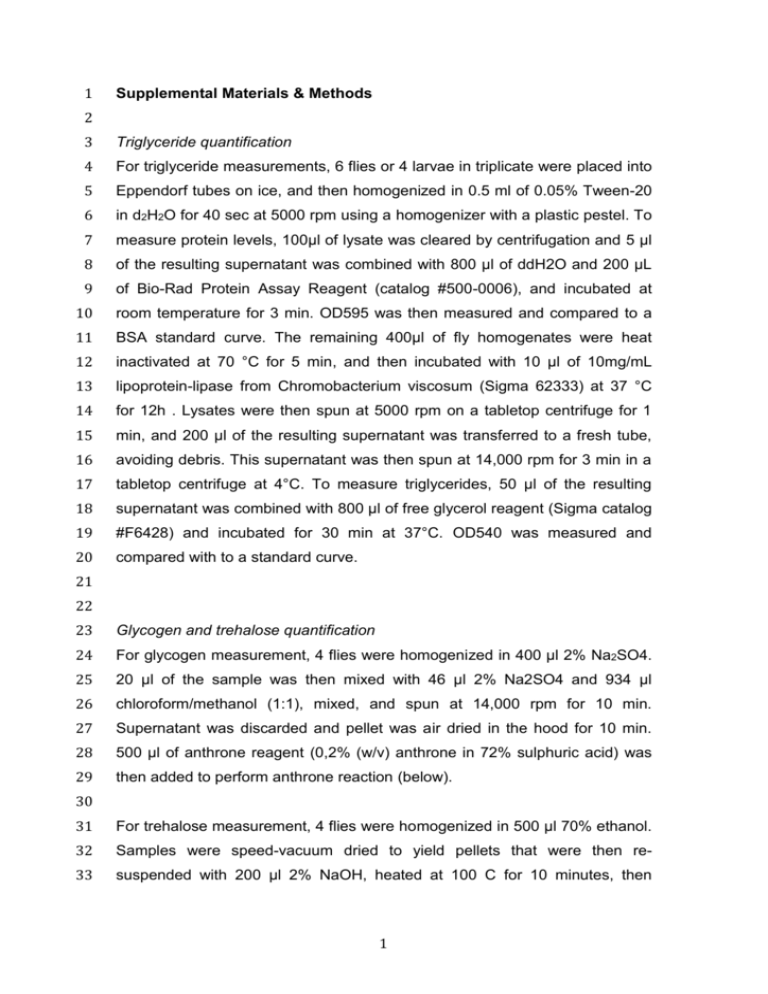
1 Supplemental Materials & Methods 2 3 Triglyceride quantification 4 For triglyceride measurements, 6 flies or 4 larvae in triplicate were placed into 5 Eppendorf tubes on ice, and then homogenized in 0.5 ml of 0.05% Tween-20 6 in d2H2O for 40 sec at 5000 rpm using a homogenizer with a plastic pestel. To 7 measure protein levels, 100µl of lysate was cleared by centrifugation and 5 μl 8 of the resulting supernatant was combined with 800 μl of ddH2O and 200 μL 9 of Bio-Rad Protein Assay Reagent (catalog #500-0006), and incubated at 10 room temperature for 3 min. OD595 was then measured and compared to a 11 BSA standard curve. The remaining 400µl of fly homogenates were heat 12 inactivated at 70 °C for 5 min, and then incubated with 10 μl of 10mg/mL 13 lipoprotein-lipase from Chromobacterium viscosum (Sigma 62333) at 37 °C 14 for 12h . Lysates were then spun at 5000 rpm on a tabletop centrifuge for 1 15 min, and 200 μl of the resulting supernatant was transferred to a fresh tube, 16 avoiding debris. This supernatant was then spun at 14,000 rpm for 3 min in a 17 tabletop centrifuge at 4°C. To measure triglycerides, 50 μl of the resulting 18 supernatant was combined with 800 μl of free glycerol reagent (Sigma catalog 19 #F6428) and incubated for 30 min at 37°C. OD540 was measured and 20 compared with to a standard curve. 21 22 23 Glycogen and trehalose quantification 24 For glycogen measurement, 4 flies were homogenized in 400 μl 2% Na2SO4. 25 20 μl of the sample was then mixed with 46 μl 2% Na2SO4 and 934 μl 26 chloroform/methanol (1:1), mixed, and spun at 14,000 rpm for 10 min. 27 Supernatant was discarded and pellet was air dried in the hood for 10 min. 28 500 μl of anthrone reagent (0,2% (w/v) anthrone in 72% sulphuric acid) was 29 then added to perform anthrone reaction (below). 30 31 For trehalose measurement, 4 flies were homogenized in 500 μl 70% ethanol. 32 Samples were speed-vacuum dried to yield pellets that were then re- 33 suspended with 200 μl 2% NaOH, heated at 100 C for 10 minutes, then 1 1 cooled on ice. 100 μl of sample was then mixed with 750 μl anthrone reagent 2 (0,2% (w/v) anthrone in 72% sulphuric acid) to perform an anthrone reaction. 3 4 Anthrone reaction: Mixtures were heated at 90 C for 20 minutes with mixing 5 every 5 minutes, then cooled on ice for 10 minutes and then returned to room 6 temperature for 20 minutes. The absorbance was read at 620 nm. The 7 carbohydrate concentration was calculated using a standard curve. 8 9 10 Starvation assay 11 Growth controlled pdgy[BG] and w1118 control males were cultured on 0.8% 12 agarose/PBS (30 flies per vial) at 25 C. Vials were changed and dead animals 13 counted every ca. 4 hours. 14 15 16 Longevity assay 17 Growth controlled pdgy[BG] and w1118 control males were maintained on 18 standard lab food. Vials were changed and dead animals were counted every 19 3-4 days. 20 21 22 Lipidomic analysis: Total Lipids 23 Freeze-dried Drosophila-samples (10.0-12.3 mg) were homogenized (20 Hz 24 for 2 min) in Eppendorf-tubes with 200 µl of PBS-buffer by using zirconium 25 oxide balls (one 5 mm and two 3 mm) in a Retsch mixer mill MM400 26 homogenizer (Retsch GmbH, Haan, Germany). For lipid profiling, a 5 µl 27 aliquot was separated and spiked with an internal standard mixture consisting 28 of 29 GPCho(17:0/0:0), 30 GPGro(17:0/17:0)[rac], Cer(d18:1/17:0), GPCho(17:0/17:0), GPA(17:0/17:0), 31 GPEtn(17:0/17:0), DG(17:0/17:0/0:0)[rac] and TG(17:0/17:0/17:0). 32 aliquot of PBS-buffer was added and the lipids were extracted with 100 µl of 33 chloroform:methanol (2:1). The samples were vortexed for 2 min and after 30 34 min standing they were centrifuged at 10 000 rpm for 3 min. The lower lipid 10 lipid classes at concentration levels MG(17:0/0:0/0:0)[rac], 2 of 0.2-0.6 µg/sample: DG(17:0/17:0/0:0)[rac], A 15 µl 1 extracts were separated and another standard mixture containing 3 labelled 2 lipid 3 TG(16:0/16:0/16:0-13C3)) was added (0.1-0.2 µg/sample). 4 Protein content of the samples was determined from the homogenate (5 µl) 5 which was diluted further for Micro BCATM Protein Assay Kit (Pierce, 6 Rockford, IL, USA). Spectrophotometric determination was performed on a 7 Multiskan EX instrument (Thermo Scientific Inc., Waltham, MA, USA). The 8 lipid concentrations in the samples were normalised with the measured 9 protein content. compounds (GPCho(16:1/0:0-D3), GPCho(16:1/16:1-D6), 10 11 The UPLC/MS system consisted of an Acquity Ultra Performance LC TM 12 (UPLC) combined with a Waters Q-Tof Premier mass spectrometer. A sample 13 organizer is used for the automatic sampling. 14 The UPLC gradient started at 65% A / 35% B (AcCN / 2-Propanol, 1:1), and 15 reached 80% B in 2 min, 100% B in 7 min and remained there for 7 min. The 16 total run time including a 4 min re-equilibration step in initial conditions was 18 17 min. The temperature of the column (Acquity UPLC® BEH C 18 1.7 µm 2.1 × 18 100 mm; Waters Inc., Wexford, Ireland) was 50 °C, the flow rate 0.400 ml/min 19 and the injected amount of lipid extract was 1 µl. The temperature of the 20 sample organizer was 10 °C. 21 22 Lipids were detected by using electrospray ionization in positive ion mode. 23 The data was collected in centroid mode at mass range of m/z 300-1200 with 24 a scan duration of 0.2 s. Data was processed using the MZmine 2 software 25 and lipids were identified using internal spectral libraries. 26 27 Lipidomic Analysis: Free fatty acids 28 10 mg tissue was weighted, 200 µl chloroform: methanol 0.1% BHT (2:1 v/v) 29 was added together with 40 µl internal standard (heptadecantrienoat FFA 30 C17:0 55 mg/l) and the sample was homogenized with zirconium oxide balls 31 at 25 Hz 5 minutes with Mixer Mill 301 . 300 µl NaCl 0.9 % (0.15 M) was 32 added to samples and the samples were vortexed for 2 min, incubated 30min 33 at room temperature and the lower layer was separated by centrifuging at 10 34 000 rpm for 5 min. 800ul kloroform 0.1% BHT was then added to the samples 3 1 and after vortex mixing (2 min) and incubation (30min at room temperature), 2 the lower layer was separated by centrifuging at 10 000 rpm for 5 min. 3 4 The free fatty acids were cleaned by solid-phase extraction using Waters NH2 5 cartidges (1cc part WAT 023610). The SPE cartridges were conditioned with 6 2 x 1ml chloroform, 400 µl of the extract was mixed with 100 µl of chloroform 7 and applied to the SPE cartridges. The cartridges were washed with 2 x 1ml 8 chloroform, and the free fatty acids were eluted with 2 x 1 ml 2 % acetic acid 9 in diethyl ether. The extractes were evaporated to dryness and silyated with 10 50ul MSTFA 1% trimethylchlorosilane (45 C, 1 h). 11 12 100 ul of the original extract was used for the determination of fatty acids. The 13 extract was evaporated to dryness after addition of 10ul internal standard 14 triheptadecanoic acid 582,5 mg/l. The evaporation residue was dissolved into 15 petroleum ether (b.p. 40-60 °C; 700 µl). Fatty acids were transmethylated with 16 sodium methoxide (NaOMe; 0.5 M; 250 µl) in dry methanol by boiling at 45 °C 17 for 5 min. The mixture was acidified with 15% sodium hydrogen sulphate 18 (NaHSO4; 500 µl) and the petroleum ether phase containing the fatty acid 19 methyl esters (FAME) as well as free fatty acids (FFA) was collected. After 20 centrifugation (10 000 rpm, 5 min) the petroleum ether layer was separated 21 into a GC vial and evaporated, the residue was dissolved into hexane (100 µl) 22 and 2 µl aliquot was used for GC analysis. 23 24 The samples (1 µl aliquots) were analysed on an Agilent 6890 gas 25 chromatograph (GC) combined with Agilent 5973 mass selective detector 26 (MSD). A splitless injection method was used and the injector and MSD 27 interface temperatures were 260 °C and 280 °C, respectively. FFAs were 28 analysed on an RTX-5 (5% phenyl methyl siloxane) capillary column (20m, ID 29 180 µm, film thickness 0.2 µm, Restek 40202) by using helium as carrier gas 30 at constant flow mode (1.2 ml/min). FFAs were monitored at m/z 285 (14:0), 31 311 (16:1), 313 (16:0), 335 (18:3n-6), 337 (18:2n-6), 339 (18:1n-9), 32 (18:3n-3), 339 (18:1n-7), 341 (18:0), 361 (20:4n-6), 359 (20:5n-3), 363 (20:3n- 33 6), 387 (22:5n-6), 385 (22:6n-3) and m/z 387 (22:5n-3). FAMEs were 34 analysed with Agilent 5890 series II GC was equipped with a 25 m HP-FFAP 4 335 1 Polyethylene Glycol TP: B006 column (25m. ID 200 µm, film thickness 0.3um) 2 and helium was used as carrier gas. The temperatures of the GC injector 3 (injection volume 1 μl) and detector (FID) were 260 and 300 °C, respectively, 4 and the oven was programmed from 70 to 240 °C at 7 °C/min. 5 6 7 Chromatin IPs 8 Chromatin immunoprecipitation was performed as described before (Teleman 9 et al., 2008). Quantitative PCR primer sequences are below. 10 11 12 Cell culture 13 Adipocytes were differentiated from murine 3T3-L1 as previously described 14 (Bortell et al., 1992). Murine C2C12 skeletal myoblasts were cultured in 15 DMEM with 10% FBS and their differentiation was induced using DMEM 16 lacking FBS but supplemented with 2% horse serum. Hepa1.6 cells were 17 cultured in DMEM supplemented with 10% serum. Cells were serum starved 18 for 1 hour (3T3-L1) or for 4 hours (Hepa1.6 and C2C12), and then treated with 19 or without insulin (5 μg/ml for 3T3-L1 and Hepa1.6, 100nM for C2C12) for 1 20 (3T3-L1 and Hepa1.6) or 2 hours (C2C12). Beta-actin served as normalization 21 control. 22 23 Generation of stable 3T3L1 cell line with ACSL4 Knock down. 24 pLKO.1 Puro vectors carrying short hairpin RNA (shRNA) for ACSL4 (Sigma 25 MISSION shRNAs) were cotransfected with the packaging plasmids PCMV- 26 d78.74 27 lentiviruses was collected 24h and 48h post transfection, centrifuged, filtered 28 through a 0.45 µm filter and stored at -80oC. Undifferentiated 3T3L1 cells 29 were infected with these combined viruses in DMEM medium. 24hr following 30 infection, medium was changed to DMEM containing 3 µm/ml puromycin for 31 selection of cells. and pMD2G into HEK293T/N17 cells. The media containing 32 33 Triglycerides analysis in differentiated 3T3-L1 cells treated with siRNA 5 1 3T3-L1 cells were seeded at 90% confluence (Day 0) in 24-well plates with 2 DMEM medium (1g/L glucose) supplemented with 10% FBS. On day 1 3 siRNAs were transfected using DharmaFECT.1 according to manufacturer’s 4 instructions (Dharmacon). Final concentration for all siRNAs was 100nM. 5 siRNA were from Ambion, and IDs and sequences are shown in the table 6 below. On day 3, medium was replaced with differentiation medium 1 (DMEM- 7 4.5g/L glucose with 10% FBS, 1µM Dexamethasone, 0.5 µM IBMX, 5 µg/ml 8 insulin). On day 5, medium was replaced with medium 2 (DMEM-HG with 9 10% FBS, 5 µg/ml insulin) for 2 days and then maintained in DMEM-HG with 10 10% FBS for 3 more days. Cells were then lysed in 100 µl TN buffer (150mM 11 NaCl, 50mM Tris pH7.5, 1% TritonX-100) on ice for 10 min. Cell lysates were 12 collected and mixed by brief vortexing. Protein content was analyzed with 13 Bradford assay and triglycerides were measured as described above. 14 15 siRNAs gene ID sense antisense ACSL1-1 s65832 CACUGAUGGUAUUCGAAGAtt UCUUCGAAUACCAUCAGUGgt ACSL1-2 s65833 GGAUGCUUCUCUUACUCAAtt UUGAGUAAGAGAAGCAUCCtt ACSL3 s231894 CACGUGAAAUUUUAAAUGAtt UCAUUUAAAAUUUCACGUGtt 16 17 Luciferase assay 18 As previously described (Teleman et al., 2008), test firefly luciferase 19 constructs were co-transfected with a normalization control construct (renilla 20 luciferase under control of a basal Adh promoter) together with a copper- 21 inducible FOXO expression construct (pMT-FOXO) into S2 cells grown in 22 Schneider’s medium supplemented with 10% FCS, using Effectene reagent 23 (Qiagen). Expression of FOXO was either induced or not via addition of cupric 24 sulfate, and luciferase activity measured as described (Teleman et al., 2008). 25 All the experiments were performed in triplicate. Firefly luciferase activity was 26 normalized by the renilla value in each well. 27 28 Food intake assay 29 Six, male, growth-controlled, 3rd instar larvae (96h AEL) or adults were kept 30 on food supplemented with 0.8% Blue9 (erioglaucine disodium salt) for 20 31 minutes, or 2 hours respectively. Animals were then homogenized in PBS, 6 1 lysates were spun at 14,000 rpm on a tabletop centrifuge for 20 min, and 200 2 μl of the resulting supernatant was transferred to a 96-well plate, avoiding 3 debris. Absorbance at 625 nm was recorded by Tecan plate-reader. For blank 4 measurements, equivalent lysates were prepared from animals fed on food 5 without dye. 6 7 Nile red staining 8 Growth controlled early L3 larvae were starved on 0.8% agarose/PBS for 0 or 9 24 hours, Fat bodies were stained with Nile red as described (Palanker et al., 10 2009). 11 12 13 Immunofluorescence staining 14 S2 cells were transfected with pMT-pudgy-HA and Tubulin:mito-GFP on glass 15 coverslips. Twenty-four hours after induction with copper, the cover slips were 16 rinsed with PBS once and fixed for 15 min with 4% paraformaldehyde in PBS 17 warmed to room temperature. The cover slips were rinsed twice with PBS and 18 cells were permeabilized with 0.2% Triton X-100 in PBS for 5 min. After 19 rinsing twice with PBS, the cover slips were blocked with 5% BSA in PBS for 20 30 min, then incubated with primary antibody in 5% BSA in PBS with 0.2% 21 triton X-100 for 2 hr at room temperature, then rinsed four times with PBS, 22 and then incubated with secondary antibodies produced in donkey (diluted 23 1:1000 in 5% BSA with 02.% triton X-100) for 40 min at room temperature in 24 the dark. After washing four times with PBS, cover slips were mounted onto 25 slides and imaged with a Leica SP5 confocol microscope. 26 27 Colocalization analysis on immunofluorescence micrographs 28 Co-localization analysis was performed on 8 independent images of S2 cells 29 stained for pudgy-HA and mito-GFP using the using the JACoP plugin (Bolte 30 et al., 2006) for ImageJ. 31 32 Quantitative RT–PCR 33 Total RNA was obtained from larval tissues or adult flies by homogenization in 34 TRIzol reagent (Invitrogen catalog #15596-018). Two micrograms of total 7 1 RNA from each sample was used to generate first-strand cDNA using the 2 SuperScript III kit (Invitrogen 11752-250) using the poly(dT) method. 3 Quantitative RT–PCR was then done on the Applied Biosystems ABI 4 StepOnePlus Real-time RT–PCR system using the SYBR Green PCR master 5 mix (ABI catalog #4309155). All assays were done in triplicate and normalized 6 to rp49 levels, and errors were propagated in all calculations. 7 8 9 10 Oligos Oligos for Genomic Quantitative-PCR (for Chromatin IPs) gene 5' oligo 3' oligo 4E-BP CGGCAATAACAACAAGAACC GGTCGGCTGATGTTTTTTG mir278 CGGGTCGGTGGGACTTTC GACGGCAGGTGCAAGACAG sty AATCGGCGAGGATGAGTG TGGCACAGCGAACAAAGT P1 TCTCCATCGCTGTGTAAACA CCCGAGCCAATTGTTGAATA P2 CCTTTTGGCCGTAATAGTG TGACGGGTTGTGCTGATAA 11 12 Oligos for Quantitative RT-PCR on selected genes. 13 Additional oligo sequences available upon request. gene 5' oligo 3' oligo CG9009 CGGGACTGACGGTGACCA CGGATACCGTTCCCACCA 4EBP CACCACTCCTGGAGGCACCAA GAAGGGAGTACGCGGAGTTC rp49 GCTAAGCTGTCGCACAAA TCCGGTGGGCAGCATGTG mAcsm1 GATTTGTGGCCTGCAGCAA GCATGCAGCCCACTGTCA mAcsm2 CCCAGGAAGGTGGAGTTCGT CGAAGCTTTGCTCGCTCAAT mAcsm3 GCACACTATTTGCCCCGTTT TAGGCAGTTGGTGCAGAACAGA mAcsm4 TTCTGGACCAGTGGTCCCTAA CCTCATCTCCTTTCCCATTCAC mAcsm5 TGTCCCTCCCTCCAAACCA AAGCCGCTCTCAGGAGTTCTC mAcsf3 CTGAGCACCCACCGTAACCT TTTTTAGTCCACGCCCATGAG ACSL1 GTATGCCACCAGGCCTAAGG CAGTGGTACCCGCTATTTCCA ACSL3 TCTTGCAAACAAAGCTGAAGGA AGGCTTCCCATCAACAGTAATGA ACSL4 ACCATTGCCATTTTCTGTGAGA GTGGCATATAAAGTCACAAGTGGAA ACSL5 TCCTCAAATTTCTGGAGCCTATCT TGAGCCAAGGGAAGGTAGGAT ACSL6 CTCCTGAAGCAGTCGGAAGAA TGCAACCCCCAATCACAGA ACSVL1 TGTGCAACACACCGCAGAA GCCATTTCCCAGGGCTTTT 8 ACSVL2 GGTGGTGGGCGGAGATTT GAATCCTTCATTCCCCAAACTCT ACSVL3 CCCCTTCCTGGGCTATGC AAAACGTCCCCAGACCAGAA ACSVL4 CCACTCAGCAGGAAACATCGT CTTCCGGATCACCACAGTCA ACSVL5 CGAGGCGAGACCTCTTTGG CGGTGTCGTCGCAGCTCTA ACSVL6 GGGCCAGTGTGCTGATTGT TTGTATGACCCGCTCATGTGA ACTB GGCTGTATTCCCCTCCATCG CCAGTTGGTAACAATGCCATGT 1 2 Cloning oligos cloning 5' oligo 3' oligo GTTGGTACCATGTCCGTCCTGA GGGTCTAGATTACTTGTACAGCTCG mito-GFP CGCCGCT TCCA pUAST- GGGCTCGAGATGAACCCAGCC GGGTCTAGATTAATCGGAGAACTTC CG9009 GCTCAA TC gggGGTACCATGAACCCAGCCG GGGGTCGACTTACGGCGTAGTCGG CTCAA GCACGTCGTAGGGGTAGGATCCAT CG9009-HA CG9009>>Luc CGGAGAACTTCTCCTT GAGGGTACCAATTTGGAACGC GGGGGTACCAAGTACAAAGTTCGC AGAGAA CTT 3 4 5 References 6 Bolte, S. and Cordelieres, F.P. (2006) A guided tour into subcellular 7 colocalization analysis in light microscopy. J Microsc 224: 213-232. 8 Bortell, R., van Wijnen, A.J., Ramsey-Ewing, A.L., Stein, G.S., and Stein, J.L. 9 (1992). Differential regulation of H4 histone gene expression in 3T3-L1 10 pre-adipocytes during arrest of proliferation following contact inhibition or 11 differentiation and its modulation by TGF beta 1. Journal of cellular 12 biochemistry 50, 62-72. 13 Palanker, L., Tennessen, J.M., Lam, G., Thummel, C.S. (2009) Drosophila 14 HNF4 regulates lipid mobilization and beta-oxidation. Cell metabolism 9, 15 228-239. 16 Teleman, A.A., Hietakangas, V., Sayadian, A.C., and Cohen, S.M. (2008). 17 Nutritional control of protein biosynthetic capacity by insulin via Myc in 18 Drosophila. Cell metabolism 7, 21-32. 19 9 1 10


